Introduction
While most people would agree that a job or an occupation is an essential part of life, individuals view work differently. Some people consider their job simply as a means to monetary compensation, while others consider it to be what defines their social status. We spend much of our time in the workplace; thus, we hope to find some personal interest and job satisfaction there since bringing the happiness and peace of mind is necessary to balance our personal lives and affects family and social relationships. From an employer’s standpoint, it is in their interests to create a work environment where employees feel motivated and encouraged to apply their full energies.
The focus of this study is to identify the factors that influence employee satisfaction and performance, with a view of helping business managers to attract, motivate and retain their employees in the long term. The term ‘employee satisfaction’ describes the way an individual feels, thinks, and perceives his/her job, encompassing the positive and negative sentiments that influence the way an employee performs his/her work tasks. Employee satisfaction has a direct bearing on behavior in the workplace, with a good level of employee satisfaction improving the retention rate of employees and minimizing recruiting and training expenses. Satisfied employees perform their tasks better, and long-term employees usually have a greater level of skill and expertise, both of which lead to increased performance. Since high employee satisfaction can be seen to lead to smooth operations in the workplace and result in higher profits, it is crucial for managers to understand the key factors that increase employee satisfaction and, therefore, performance. This study will potentially assist human resources departments and top management in Jordanian industry to focus their efforts on the factors that most influence employee satisfaction which directly affect job retention and employee turnover. By studying the factors of wages, organizational culture, benefits, stress, training and development, promotion system, and job security, we will be able to deduce the percentage of influence for each factor. A survey has been carried out among Jordanian industrial employees to pinpoint the reality behind job satisfaction and high performance, also taking into account how the employee’s age, education level, job position, and type of job affect attitudes toward work.
Literature Review
Wages
Previous studies by Frye (2004) show that there is a positive relationship between wages and employee performance and that income is the major factor of employee satisfaction. A survey by Nguyen et al. (2003) also showed that job satisfaction is positively affected by wages. These findings have been corroborated by numerous researchers (Cappelli & Sherer, 1988, Brown et al., 2008). Kathawala, Moore & Elmuti (1990) concluded that the salary system is the sole motivating factor for employees in the automobile industry. They also state that compensations and rewards are important tools to control employee turnover rate. Hamermesh (2001) found that an increase in the salary has only temporary effects on employee satisfaction. In the other hand, According to Wang & Seifert (2017), wages cut can affect employees’ moral. Also, employees’ performances tend to go to the wrong direction. Therefore, most of the companies during recession tend to lay off people instead of cutting payment.
The roots of the payment for performance idea stems from a reinforcement theory which suggests that payment can be linked to employee performance. Heneman (1992) suggested that managers set target goals and reward employees who meet them with a scheme of bonuses for achievement, consequently raising the overall performance.
Organizational Culture
Organizational culture can be defined as the set of characteristics that makes a company unique and distinguishes it from other companies, or as the way by which employees within a company interact and the work environment that this interaction creates. Researchers have expanded the definition of organizational culture, with Lee &Yu (2004) stating that it is the unique quality and organization style of a given workplace, while Abu-Jarad, Yusof, & Nikbin (2010) defined it as how things are done and dealt within an organization, as well as being a way for new employees to gauge how to interact with colleagues. Alvesson & Spicer (2012) affirmed that culture encompasses a shared set of key values, understandings, assumptions, and norms among a company’s employees. Organizational culture can be viewed as the normative binding that holds the entire organization together (Tichy, 1982).
Organizational culture can have either a positive or a negative impact on employee motivation and performance. Previous studies had determined the relationship between culture and commitment. Yıldırım et al. (2016) found that positive culture increased the commitment of the employees. Also, marketing culture can influence the performance of the employees (Al- Mohammad, 2014). A successful culture encourages employees to perform their work tasks with energy and enthusiasm. The more encouraging and positive the culture, the greater the job satisfaction, the level of commitment and the consequent efforts expended by employees. When employees consider themselves crucial to the company growth, they take responsibility for the organization’s overall well-being. Overt recognition and appreciation of good performance leads employees to perform better in order to achieve their personal work goals and those of the company. In addition, innovative culture and effective working environment can promote effective changes and generate high quality service and product. Also, strong culture can attract talented employees and reduce turnover rate (Kim et al., 2017).
On the other hand, in a culture where managers fail to empower their employees, anxiety and distrust become the norm. Employees don’t feel involved in the overall company operation, don’t perceive their role as important to the company, and thus tend to have low interest and satisfaction which negatively affects their performance. A weak organizational culture that doesn’t value team work and unity may suffer from a lack of cooperation, and possibly creates a conflict between individuals and departments, thus greatly damages the overall health of the company. Since organizational culture is clearly a factor affecting satisfaction and performance in the workplace, Jordanian industry needs to focus on eliminating negative factors that hinder employee performance and concentrate on the factors that ameliorate satisfaction.
The ideal culture is the one in which employees hold similar ethical values, communicate well and form a cohesive team. Jordanian companies need to be aware of the benefits of enhancing their organizational culture and of shaping the work environment to one where company goals can be achieved and where employees know their tasks and responsibilities and understand assessment procedures Thus, they will be able to reap the rewards of their skills and productivity.
Job Satisfaction
Job satisfaction is an individual’s subjective viewpoint encompassing the way he/she feels about his/her job and the employing organization. Moreover, job satisfaction is the pleasurable emotional state that results from the achievement of job values (Courtney &Younkyoung, 2017). Each individual has different criteria for measuring job satisfaction. Influencing factors are payment, working hours, schedule, benefits, level of stress, and flexibility. Job satisfaction has been linked to productivity, motivation, performance, and life satisfaction (Landy, 1978), while Locke (1976, p.1304) defined it as “a pleasurable or positive emotional state resulting from the appraisal of one’s job or job experiences”. Research suggests that job satisfaction has emotional and behavioral components. The emotional components are the feelings of happiness, anxiety, boredom, and excitement evoked by the job. The behavioral components include early arrival, tardiness, working late, or faking illness in order to avoid work (Bernstein & Nash, 2008).
Mueller & Kim (2008) identified two types of job satisfaction; firstly, the overall feeling about the job, and secondly, the feelings about the aspects of the job, such as benefits, salary, position, growth opportunities, work environment, and the relationships among employees. The considerable time spent by employees at the work place makes job satisfaction a significant factor since dissatisfaction can have an adverse impact on the individual’s personal life. Saari & Judge (2004) indicate that the relationship between job satisfaction and performance is more important for those doing difficult jobs than for those in less demanding jobs.
Stress
Employees who find themselves subject to greater demands and responsibilities than they are capable of handling suffer from raised stress levels which can be detrimental to an employee’s emotional and physical responses, thus, causing challenges for both the employee and the organization (Leong, Furnham, & Cooper, 1996). Research has linked work stress to role ambiguity and role conflict (Chang, 2008) and indicated that certain factors, such as work overload and poor working conditions often result in negative mental and physical health consequences for employees (Murphy, Cooper, & Payne, 1988).
According to Schabracq & Cooper (2000), stress is a key factor of low motivation and morale which lead to low performance, high turnover, low job satisfaction, increased absenteeism, and low quality products and services. Since stress can directly affect organizational efficiency, Jordanian companies need to identify the root cause of job stress and find ways of controlling stress factors that impact employees’ satisfaction and performance.
Training and Development
With globalization, technology, and leadership style which bring increased competition among businesses worldwide, companies must attract and retain talented employees in order to survive in the market (Allen, 2010). Employee roles should be clear-cut in order for them to perform well and contribute to the company’s success. Thus, human resource management should focus on training and development so that employees can keep pace with new technologies and the current market. Employees should receive up-dated knowledge in the field to be aware of the company’s mission and goals. Garner (2012) states that training and development are basic needs to increase employee’s accuracy role, reduce the role of conflicts among employees, and enhance the on-going learning process so that employees can adapt to changes in company practice (Masa’deh et al., 2013; Shannak et al., 2010).
Armstrong (2009) distinguishes between the concepts of training and development; identifying development as the new skills and knowledge that an employee gains from his/her company that help to fit and progress into a future position. Training helps employees to practice their current skills to a better standard, thus increasing performance and helping them to advance in the workplace. Training and development serve to enhance the confidence of employees and can consequently improve their general attitude toward the company. Adequate knowledge and information about their roles and the products or services they are providing helps employees perform better on the job, thus, making them better equipped to assist customers. Furthermore, training and development can spur employees to think creatively.
According to Gusdorf (2009), a change in business environment and practices has led to an increase in training and development and talent inventory management. The appropriate training can alleviate many workplace challenges, such as team work, employee conflict, innovation, and organizational culture. Training and development sessions not only prepare employees for the next step on the promotional ladder, but they can also strengthen employer-employee bonds, enabling the employer to distinguish employee performance and talent (Qayyum et al., 2012). Vemic (2007) points out that when employees possess adequate knowledge and experience, they feel confident enough to become part of the decision-making process. Moreover, when top management promotes strong organizational learning culture, employees expand their knowledge and skills through training (Malik & Kanwal, 2016).
Saleem et al. (2011) identify some of the benefits of training and development as the tools to improve human capital, enhance skills, increase employee knowledge and work efficiency, reduce non-productive work time such as sick days, and reduce absenteeism, as well as increase quality by reducing employee error and the resulting wastage. According to Obisi (2011), training should aim to enhance employees’ skills and performance in the workplace. The strength and capabilities of the company are derived from those of its employees. Each employee’s performance contributes to the company’s success, so the stronger the employees’ performance, the more likely the company is to achieve its goals. Also, In order to promote learning culture, top management needs to be involved in the training program (Tom & Harris, 2017).
Promotion
Promotion can be defined as the internal mobility within the company by changing position vertically. Many employees find that holding the same position and repeating the same daily tasks for many years is tedious, but that can be avoided if the employee has the expectation of gaining promotion to a higher position with new tasks and responsibilities. As Prasad (2010) points out, it is rare to see an employee remaining in one position for twenty years. He/she either gains promotion or seeks new challenges elsewhere. Moreover, promotion brings higher status and better payment, as well as the feeling that hard work and loyalty are recognized and rewarded.
Company promotion policies and procedures play a big role in employee satisfaction. Some companies have a policy of internal promotion, while other companies prefer to recruit new employees to vacant positions. Successful companies reward their best employees with promotions, since obvious appreciation and reward from management encourage the employee to maximize his/her efforts, and thus, increase productivity. Naturally, an employee who enjoys high self-esteem will perform tasks confidently and efficiently, which is beneficial to the organization as a whole. A pro-active employee will seek advancement through education, training and development programs, thus enhancing their skills and experience in order to be recognized by management as somebody worthy of promotion (Gupta, 2011; abuhashesh, 2014).
According to Armstrong (2009), companies looking to increase stability and retain long- term employees should strengthen employer-employee relationships by creating trust and loyalty through a policy of internal promotion. Employee trust and loyalty can help the company to achieve its goals and gain long-term market success. Some companies use promotion on merit as a means of motivating employees. Merit policy is a fair method that encourages employees to work harder and stay loyal to the company because they know that ultimately the reward will be a promotion to a higher position, leading to higher wages and greater status. The result is increased job satisfaction, better performance and further advancement.
Human resources departments can play an important role in making employees more motivated and engaged by implementing programs that can enhance performance and the desire to accept promotional challenges which allow employees to exercise higher level of skills and responsibility in the new position.
Job Security
Job security refers to the length of time employees can expect to remain in their job. In general, employees prefer to find a job that they can occupy in the long term, which works to the benefit of the company. Some companies offer lengthy contracts which protect employees from job termination. According to Shi (2017), job security is positively related to social safety. Employees with vulnerable position will increase their performance in order to maintain their high social status. Other studies have shown that job insecurity reduces employee commitment, satisfaction and performance (Ashford et al. 1989). Rosow & Zager (1985), however, found no relationship between job insecurity and job performance.
According to Iverson (1996), job security leads to increased employee commitment, with long-term employees showing a stronger sense of loyalty. Lifetime employment and seniority changes employee performance and creates a sense of leadership. Personal factors, such as the age of the employee, level of education, number of children, position level, and income combine to encourage employees to remain in the job. As an employee gets older and has greater personal responsibilities, the need for job security increases. A long-term employee often has greater skill levels, which means they perform tasks to a higher standard and are more productive. In contrast, a company that cannot ensure job security will find that its employees quickly seek more stable employment with less risk, causing that company to suffer from high turnover rate which will affect it negatively. Low productivity and increased outlay in training new staff can result in higher prices passed on to customers and can provoke customer dissatisfaction. When a company loses its customers trust, it will inevitably lose business and revenue.
Methodology
Here, we discuss the research design and provide a detailed outline of the approach used, and highlight the elements of the study. We applied the quantitative approach, focusing on two sources of information: we benefitted from past findings by examining previous academic literature, and made new findings through a survey of industrial sector employees. The sources both carry their advantages and disadvantages, but they do serve to complement each other to provide a full picture of the factors that most impact employee performance and satisfaction in the Jordanian industrial sector.
Research Design
The study seeks to understand the factors that impact employee satisfaction and performance among workers in Jordan’s industrial sector, with a view to help Jordanian companies to utilize those factors to maximize their efforts in increasing employee satisfaction. When Jordanian companies understand the degree of influence brought by the factors of wages, organizational culture, job satisfaction, work stress, training and development, promotion, and job security on performance, they can use that knowledge to control and minimize turnover rate. Moreover, the study will offer recommendations on how to meet that purpose by positively impacting employee satisfaction.
According to Creswell (2009), a research design is a plan on how to conduct a research project. The primary method of data collection is a survey distributed to workers in Jordan’s industrial sector designed to measure the factors that most heavily impact employee performance and satisfaction. 147 valid responses were received and the data was converted into numbers to allow the analysis of these numbers through statistical procedures, thus, revealing the relationship between the determined variables. The variables of the study are contained in five hypotheses, as follows:
H1: There is a positive relationship between the level of wages and employee satisfaction.
H2: There is a negative relationship between stress and employee performance.
H3: Training and development has a positive impact on employee satisfaction.
H4: Job security has a significant negative impact on turnover rate.
H5: Employee satisfaction has a positive impact on employee performance.
Sampling
The research population is employees in the industrial sector in Jordan. Random sampling was used to increase the probability of fair selection among members of the population. To take a random sample, a procedure must be formulated to make sure that each member of the population has equal probability of being selected and this must be done prior to selecting members to make sure bias sampling does not occur (Davies, 2007). An unbiased sample helps the researcher to achieve accurate data, gives a better generalization about the entire population, and saves time and money. Validity is important to accurately reflect the research concept under examination. Reliability focuses on the accuracy of the measuring procedure.
Survey Analysis – Data Processing and Results
Introduction
Here, we will describe the study sample in terms of gender, age, monthly income, and we will discuss descriptive analysis of the variables in the study. To test the hypotheses of the study, we need to find out averages and standard deviations among variables by using one sample T- test.
Descriptive Analysis of Sample
The study sample consisted of 147 valid responses to a survey that was distributed randomly among Jordanian industrial factory employees. The sample consisted of 76.9% males, and 23.1% females. 58.5% of respondents were aged 25 – 34, 34.19% were between 18 and 24, and 17 % were aged between 35 and 44 years. 61.2% had a monthly income of between 200 – 400JD, 25.9% earned between 401 – 600JD, 8.8% earned 601 – 999JD, and 5.4% earned more than 999JD. 93.9% of sample members worked over 40 hours a week. 49.7% of the sample was married and 49.7 % was single. 27.2% of sample members held a Bachelor’s degree, and 55.8% were high school graduates. 51.7% were working in manufacturing. These analyses are expressed in the table below:
Table 1: Distribution of the study sample according to their personal variables
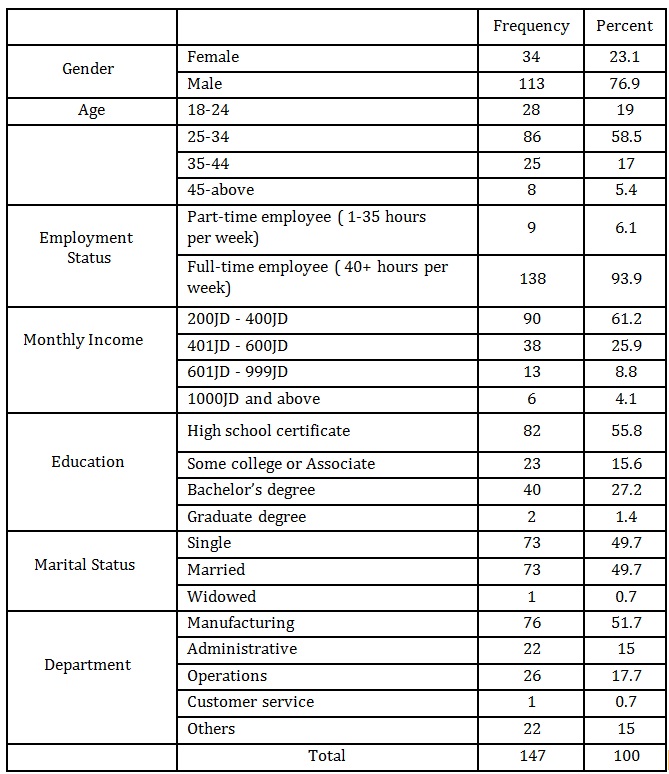
We tested the stability of the study tool using Cronbach Alpha measurement. It reached 0.83, which is valid for study purposes.
Answering the Study Questions
Which of the factors has the most impact on employee satisfaction?
The factor with the greatest impact on employee satisfaction is ‘Wages’ with a percentage of 50.3%, followed by ‘Job satisfaction’ with 16.3%, then “Job security” with 12.9%, followed by “Training and development” with 7.5%. Therefore, Jordanian employees consider wages the most important factor impacting their job satisfaction.
Which is the most important factor regarding job satisfaction?
Companies that offer comparatively higher salaries than other competitors in the same industry are attractive to employees, who also care about job security. Examining Table 2, we see that ‘Salary’ is the most important factor regarding job satisfaction with a percentage of 48.3%, followed by ‘Job security’ with 23.8%, then “Benefits” with 12.9%, and then ‘Faster promotion’ with 8.8%. ‘Stress levels’ is the least important factor with 6.1%.
Table 2: Factors affecting job satisfaction
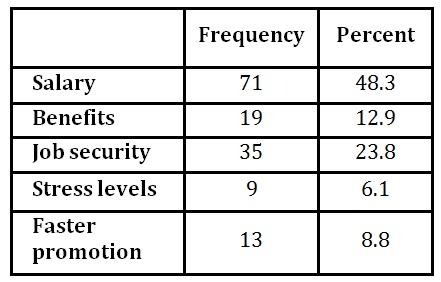
Which of the following factors most influences your decision to leave your job?
Table 3 shows the factors that affect an employee’s decision to leave a job. It is clear that the highest factor is Low salary with a percentage of 48.3%, then ‘Negative environment’ with 10.2%, then ‘Bad work conditions’ with 9.5%. ‘Poor management’ and ‘Job security’ were of low importance, each taking 8.8%. ‘High level of stress’ and ‘Low career growth’ were of the least importance in the opinion of our respondents.
Table 3: Factors influencing the decision to leave the job
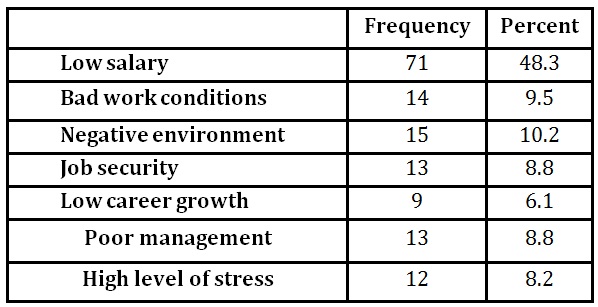
Analysis of Hypotheses
Averages were distributed to the responses of the members of the study sample as follows:
-High degree of approval: includes paragraphs that got the mean averages greater than (3.66) and the largest percentage (73.2%).
-Moderate degree of approval: includes a set of paragraphs with mean average ranging between (2.34- 3.66) and a percentage between 46.8% and 73.2%.
-Low degree of approval: includes paragraphs with mean averages of less than (2.34) and a percentage of less than 46.8%.
We have used the length category of Likert scale: (5-1)/3=1.33
H1: There is a positive relationship between high wages and employee satisfaction.
As shown in Table 4, the first hypothesis was tested using a one sample T-test.
Table 4: (One sample T-test) to test the first hypothesis
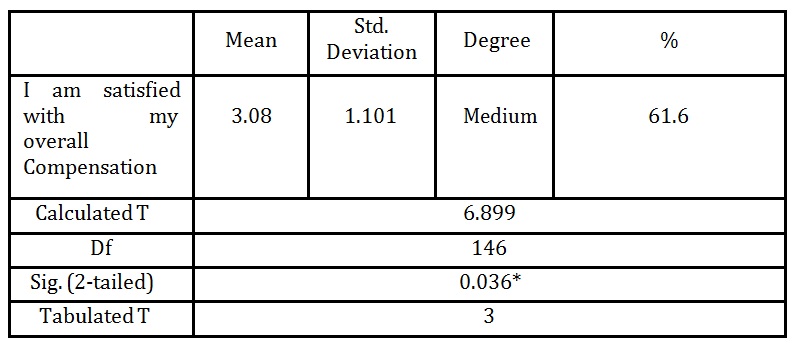
It is clear from the above table that the degree of approval was moderate. We note that the value of calculated T is more than the tabulated T at the significant value less than (0.05), which means that there is a positive relationship between high wages and employee satisfaction. We conclude that Jordanian employees care more about monetary compensation than any other factor.
H2: There is a negative relationship between stress and employee performance.
As shown in Table 5, the second hypothesis was tested using a one sample T-test.
Table 5: (One sample T-test) to test the second hypothesis
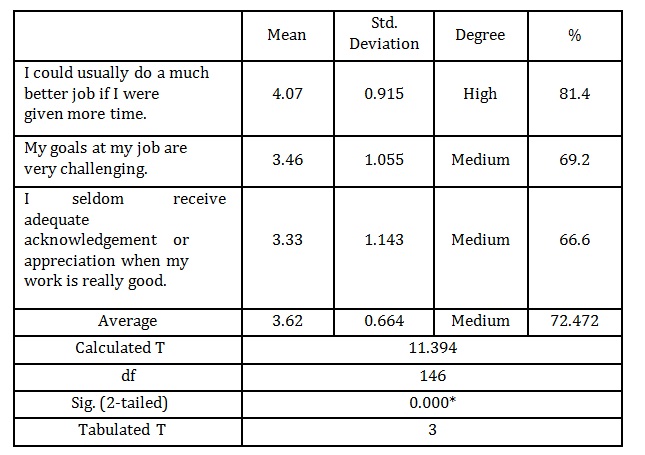
It is clear from the above table that the degree of approval was moderate for all paragraphs, except the paragraph “I could usually do a much better job if I were given more time” which got a high approval, with the overall rate of 3.62%. The average of 72.5% represents a medium approval. We also note that the value of calculated T is greater than the tabulated T at the significant value less than (0.05), so we accepted the hypothesis that there is a negative relationship between stress and employee performance. The more stress an employee faces, the lower their performance will be.
H3: Training and development has a positive impact on employee satisfaction.
As shown in Table 6, the third hypothesis was tested using a one sample T-test.
Table 6: (One sample T-test) to test the third hypothesis

It is clear from the above table that the paragraph “I am satisfied with the job-related training my organization offers” received medium approval, and the paragraph “I am satisfied with the investment my organization makes in education” received high approval. The overall rate (3.71) with a percentage of 74.3% represents a high approval. We also note that the value of calculated T is more than tabulated T at the significant value less than (0.05), which indicates that training and development has a positive impact on employee satisfaction. This means that the levels of training and education employees receive are directly linked to their satisfaction levels. Employees require the tools to do their job, even when those tools take the form of knowledge and experience through training.
H4: Job Security has a significant negative impact on turnover rate.
As shown in Table 7, the fourth hypothesis was tested using a one sample T-test.
Table 7: (One sample T-test) to test the fourth hypothesis
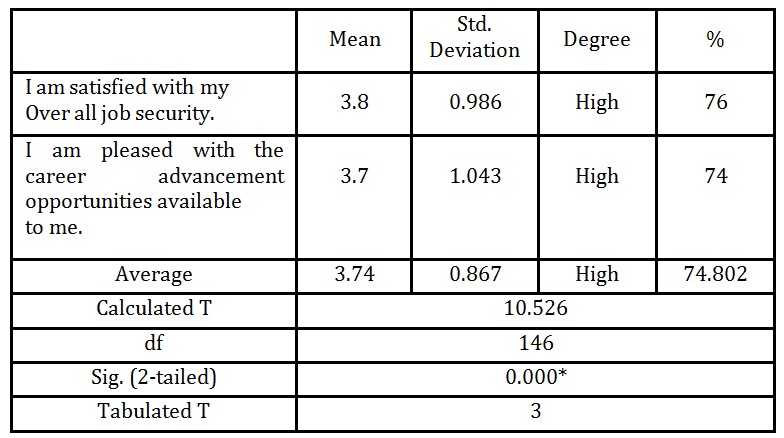
The table shows that the degree of approval came high for all paragraphs, with the overall rate at (3.74) with a percentage of 74.8%. We note that the value of calculated T is more than tabulated T at the significant value of less than (0.05), which means that Job security has a significant negative impact on turnover rate. When employees are assured of job security, they will perform better and remain in the job, thus reducing turnover rate.
H5: Employee satisfaction has a positive impact on employee performance.
As shown in Table 8, the fourth hypothesis was tested using a one sample T-test.
Table 8: (One sample T-test) to test the fifth hypothesis
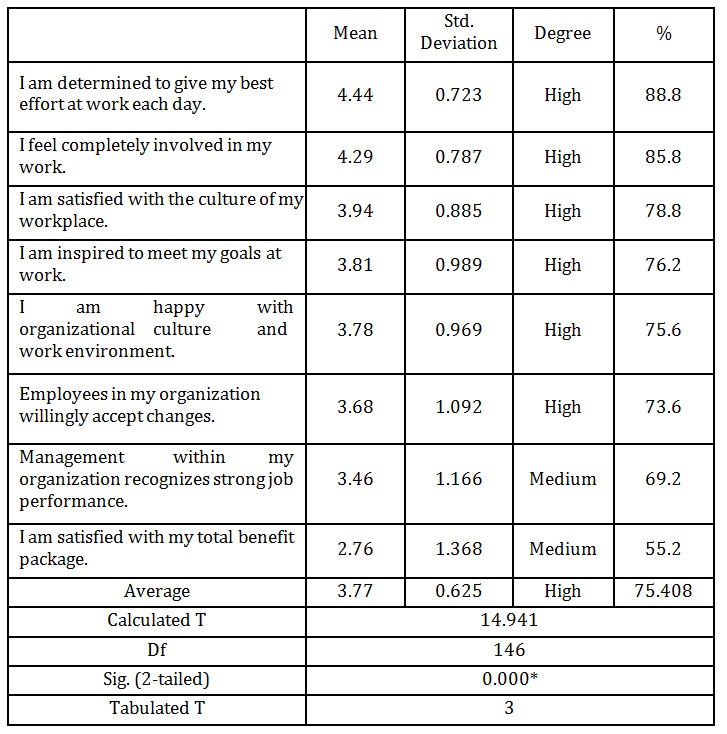
The above table shows that the degree of approval came high for all paragraphs, except the paragraphs “Management within my organization recognizes strong job performance” and “I am satisfied with my total benefit package” which both received medium approval. We noted that the value of calculated T is more than tabulated T at the significant value less than (0.05), which means that employee satisfaction has a positive impact on employee performance.
Relationship between (Gender, Age, Education, Income) and “How long have you been working in the same job?”
From Table 9, we observe the relationship between gender and the question “How long have you been working in the same job?” where the P-value is less than (0.05). We note that male respondents remained in the same job longer than females.
Relationship between (Gender) and “How long have you been working in the same job?”
Table 9: Gender with “How long have you been working in the same job?”

Relationship between (Income) and “How long have you been working in the same job?”
Table 10 shows no relationship between income and “How long have you been working in the same job?” where the P-value is more than (0.05).
Table 10: Income with “How long have you been working in the same job?”
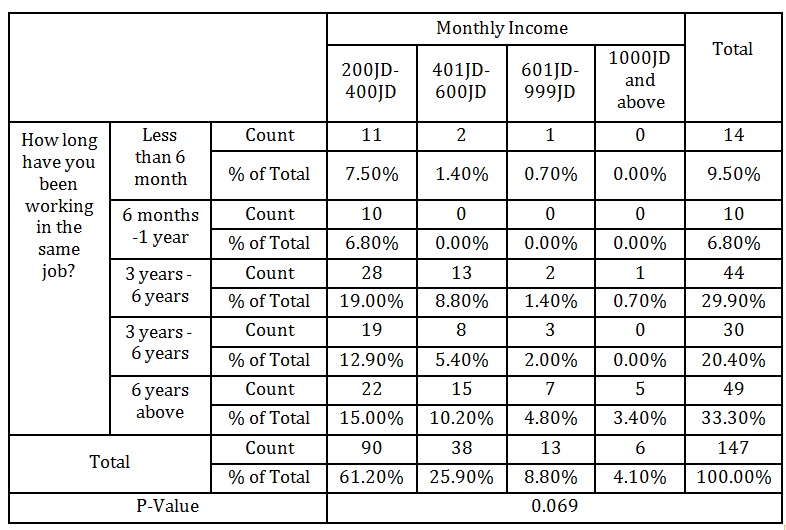
Relationship between (Education) and “How long have you been working in the same job?”
Table 11 shows no relationship between education and “How long have you been working in the same job?” where the P-value is more than (0.05).
Table 11: Education with “How long have you been working in the same job?”
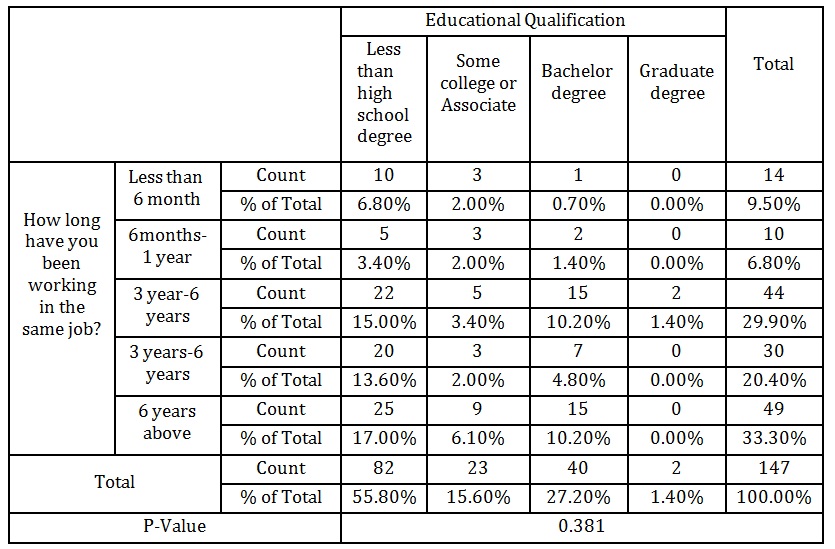
Relationship between (Gender, Age, Education, Income) and “How many times have you been promoted at your current workplace?”
Relationship between (Gender) and “How many times have you been promoted at your current workplace?”
Table 12 shows no relationship between Gender and “How many times have you been promoted at your current workplace?” where the P-value is more than (0.05).
Table 12: Gender with “How many times have you been promoted at your current workplace?”
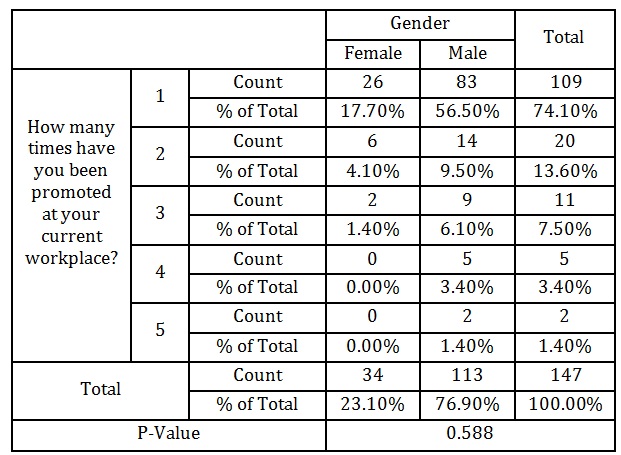
Relationship between (Age) and “How many times have you been promoted at your current workplace?”
Table 13 shows no relationship between Age and “How many times have you been promoted at your current workplace?” where the P-value is more than (0.05).
Table 13: Age with “How many times have you been promoted at your current workplace?”
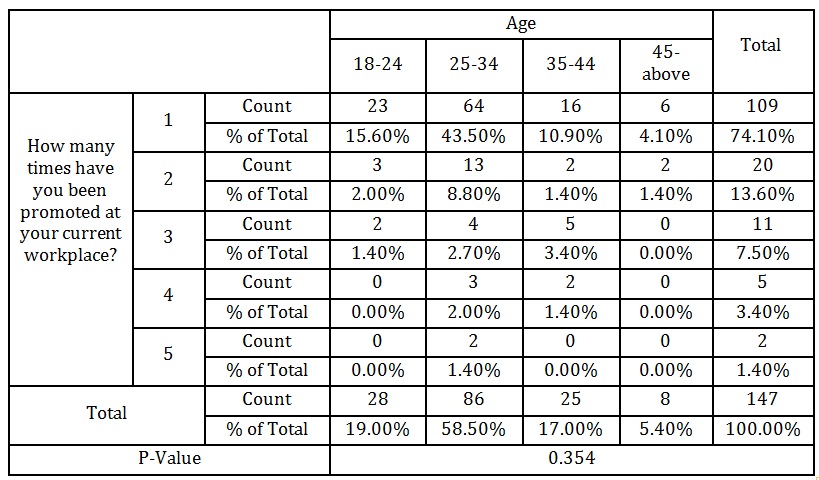
Relationship between (Income) and “How many times have you been promoted at your current workplace?”
Table 14 shows no relationship between Income and “How many times have you been promoted at your current workplace?” where the P-value is more than (0.05).
Table 14: Income with “How many times have you been promoted at your current workplace?”
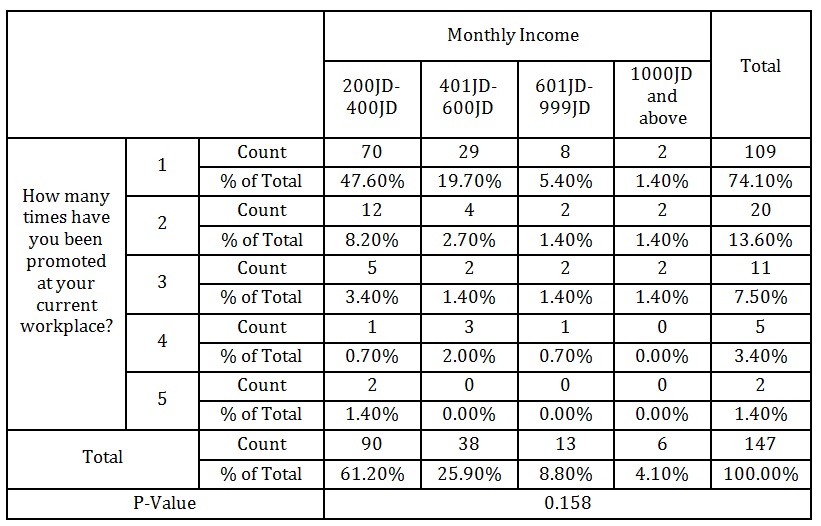
Relationship between (Gender, Age, Education, Income) and ‘Factors which most influence your decision to leave the job’
Relationship between ‘Gender’ and ‘Factors which most influence your decision to leave the job’
Table 15 shows the relationship between ‘Gender’ and ‘Factors which most influence your decision to leave the job’, where the P-value is less than (0.05). Clearly, male employees see low salary as a greater factor in their decision to leave the job than female employees.
Table 15: ‘Gender’ with ‘Factors which most influence your decision to leave the job’

Relationship between ‘Age’ and ‘Factors which most influence your decision to leave the job’
Table 16 shows no relationship between ‘Age’ and ‘Factors which most influences your decision to leave the job’, where the P-value is more than (0.05).
Table16: ‘Age’ with ‘Factors which most influence your decision to leave the job’

Relationship between ‘Education’ and ‘Factors which most influence your decision to leave the job’
Table 17 shows no relationship between ‘Education’ and ‘Factors which most influence your decision to leave the job’, where the P-value is more than (0.05).
Table17: ‘Education’ with ‘Factors which most influence your decision to leave the job’
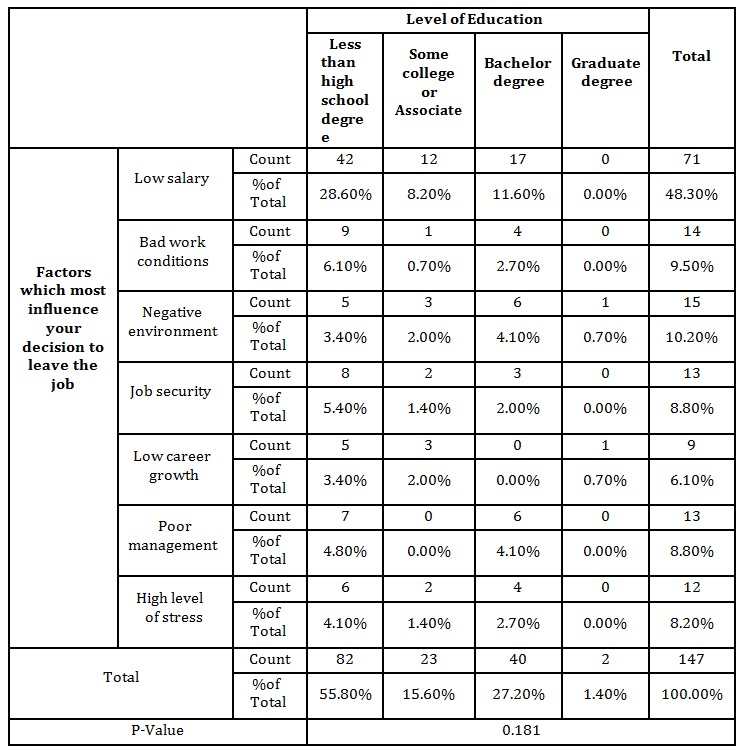
Conclusion
This study has focused on the main factors that can influence employee satisfaction and performance, with the results highlighting the factors with the biggest impact. The most important factor has been proven to be ‘Wages’, with 50.3% of our population seeing wages as very important for Jordanian employees in view of the country’s high cost of living. The nature of the job itself was considered the second most important factor, with a weighting of 16.3%. Our study shows that Jordanian people care about their positions, and the levels of challenge and excitement offered by their job. The survey indicated that Jordanian employees were prepared to leave their job in case of finding a job with a higher salary elsewhere. Based on the study result, it is evident that the two major factors that lead to employees leaving their jobs is low salary and a negative organizational culture, which together represent 58.5%.
Based on the apparent positive relationship between wages and employee satisfaction, we recommend that Jordanian companies, where possible, raise wages to exceed the industry average in order to attract and retain higher quality employees. In response to the second hypothesis, we discovered that there is a negative relationship between stress and employee performance. We noticed that influences such as an aggressive supervisor, poor communication, inadequate training, role ambiguity, and role conflict can raise the level of work-related stress. Overwhelming stress levels will naturally lead to reduced performance. On the other hand, we noticed that training and development increase employees’ skills and raise their confidence in their ability to do the job, indicating a positive relationship between training and satisfaction. Increased training helps employees feel more comfortable to perform tasks and brings about greater proficiency, which in turn gives employees internal motivation and high self-esteem.
Addressing the fourth hypothesis, we found that job security has a significant impact on the turnover rate. When employees feel that their job is secure in the long term, they will remain and perform better, thus, markedly reducing turnover rate. Job security can motivate employees to develop long term plans in their personal lives; thus, they feel contented at work, which leads to an increase in job performance. On the other hand, employees who feel their job is under threat will quickly start to look for alternative employment.
(adsbygoogle = window.adsbygoogle || []).push({});
References
- Abuhashesh, Y. (2014). Integration of social media in businesses. International Journal of Business and Social Science, 5(8), 202-209.
- Abu-Jarad, I.Y., Yusof, N.A. and Nikbin, D., 2010. A review paper on organizational culture and organizational performance. International Journal of Business and Social Science, 1(3).
- Al-Mohammad, S., Akroush, M. and Lutfi Odetallah, A., 2014. Marketing culture and business performance: Re-examination of Webster’s marketing culture measurement scale. Marketing Intelligence & Planning, 32(7), pp.794-822.
- Allen, M., 2010. Corporate universities 2010: Globalization and greater sophistication. The Journal of International Management Studies, 5(1), pp.48-53.
- Alvesson, M. and Spicer, A., 2012. A stupidity‐based theory of organizations. Journal of management studies, 49(7), pp.1194-1220.
- Armstrong, M. and Taylor, S., 2014. Armstrong’s handbook of human resource management practice. Kogan Page Publishers.
- Ashford, S.J., Lee, C. and Bobko, P., 1989. Content, cause, and consequences of job insecurity: A theory-based measure and substantive test. Academy of Management journal, 32(4), pp.803-829.
- Bernstein, D.A., and Nash, P.W. (2008)’ Essentials of Psychology’,4th ed., Boston: Cengage Learning.
- Brown, G.D., Gardner, J., Oswald, A.J. and Qian, J., 2008. Does wage rank affect employees’ well‐being?. Industrial Relations: A Journal of Economy and Society, 47(3), pp.355-389.
- Cappelli, P. and Sherer, P.D., 1988. Satisfaction, market wages, & labor relations: an airline study. Industrial Relations: A Journal of Economy and Society, 27(1), pp.56-73.
- Cronley, C. and Kim, Y.K., 2017. Intentions to turnover: Testing the moderated effects of organizational culture, as mediated by job satisfaction, within the Salvation Army. Leadership & Organization Development Journal, 38(2), pp.194-209.
- Creswell, J.W., 2009. Research design: Qualitative, quantitative, and mixed methods approaches (Vol. 4). Thousand Oaks, CA: Sage.
- Davies, G. and Dwyer, C., 2007. Qualitative methods: are you enchanted or are you alienated?. Progress in Human Geography, 31(2), pp.257-266.
- Frye, M.B., 2004. Equity‐based compensation for employees: firm performance and determinants. Journal of Financial Research, 27(1), pp.31-54.
- Garner, E., 2012. Training skills: How to improve the skills and performance of your employees. Bookboon. com.
- Gupta, C.B. (2011) Human Resource Management 19th Ed., New Delhi: Sultan Chad and Sons.
- Gusdorf, M.L. (2009) ‘Training Design, Development, & Implementation’, Society for Human Resource Management (SHRM), 1-34.
- Heneman, R.L., 1992. Merit pay: Linking pay increases to performance ratings. Addison-Wesley/Addison Wesley Longman.
- Hamermesh, D. (2001) ‘The Changing Distribution of Job Satisfaction’, Journal of Human Resources, 36(1), 1-30.
- Iverson, R.D., 1996. Employee acceptance of organizational change: the role of organizational commitment. International Journal of Human Resource Management, 7(1), pp.122-149.
- Kathawala, Y., Moore, K.J. and Elmuti, D., 1990. Preference between salary or job security increase. International Journal of Manpower, 11(7), pp.25-31.
- Kim, W.H., Ra, Y.A., Park, J.G. and Kwon, B., 2017. Role of burnout on job level, job satisfaction, and task performance. Leadership & Organization Development Journal, 38(5), pp.630-645.
- Landy, F.J., 1978. An opponent process theory of job satisfaction. Journal of Applied Psychology, 63(5), p.533.
- Kim Jean Lee, S. and Yu, K., 2004. Corporate culture and organizational performance. Journal of managerial psychology, 19(4), pp.340-359.
- Leong, C.S., Furnham, A. and Cooper, C.L., 1996. The moderating effect of organizational commitment on the occupational stress outcome relationship. Human relations, 49(10), pp.1345-1363.
- Locke, E.A. and Dunnette, M.D., 1976. Handbook of industrial and organizational psychology. The nature and causes of job satisfaction, pp.1297-1349.
- Malik, M., and Kanwal, M. ( 2016). Impacts of Organizational Knowledge Sharing Practices on Employees’ Job Satisfaction: Mediating Roles of Learning Commitment and Interpersonal Adaptability. Journal of Workplace Learning.
- Masa’deh, R., Gharaibeh, A., Maqableh, M., & Karajeh, H. (2013). An Empirical Study of Antecedents and Outcomes of Knowledge Sharing Capability in Jordanian Telecommunication Firms: A Structural Equation Modeling Approach. Life Science Journal, 10(4), 2284-2296.
- Mueller, C.W. and Kim, S.W., 2008. The contented female worker: Still a paradox?. In Justice (pp. 117-149). Emerald Group Publishing Limited.
- Nguyen, A., Taylor, J. and Bradley, S., 2003. Relative pay and job satisfaction: some new evidence.
- Obisi, C., 2011. Employee training and development in Nigerian organisaitons: Some observations and agenda for research. Australian Journal of Business and Management Research, 1(9), p.82.
- Prasad, L.M. (2010) Human Resource Management, Sultan Chand and Sons.
- Qayyum, A., Sharif, M.T., Ahmad, A. and Khan, M.S., 2012. Training & development practices in National Bank of Pakistan. Information Management and Business Review, 4(1), p.8.
- Rosow, J. M., and Zager, R. (1985), ‘The Case for Employment Security’, Across the Board, 22(1), 34–41.
- Saari, L.M. and Judge, T.A., 2004. Employee attitudes and job satisfaction. Human Resource Management: Published in Cooperation with the School of Business Administration, The University of Michigan and in alliance with the Society of Human Resources Management, 43(4), pp.395-407.
- Saleem, Q., Shahid, M. and Naseem, A., 2011. Degree of influence of training and development on employee’s behavior. International Journal of Computing and Business Research, 2(3), pp.2229-6166.
- Schabracq, M.J. and Cooper, C.L., 2000. The changing nature of work and stress. Journal of Managerial Psychology, 15(3), pp.227-241.
- Shannak, R., Obeidat, B., & Almajali, D. (2010). Information Technology Investments: A Literature Review. Proceedings of the 14th IBIMA Conference on Global Business Transformation through Innovation and Knowledge Management: An Academic Perspective, Istanbul-Turkey, 23rd-24th June, pp.1356-1368.
- Shi, B., 2017, August. An exploratory study of job insecurity in relation to household registration, employment contract, and job satisfaction in Chinese state-owned enterprises. In Evidence-based HRM: A Global Forum for Empirical Scholarship (Vol. 5, No. 2, pp. 151-165). Emerald Publishing Limited.
- Short, T. and Harris, R.M., 2017. Harmonising training and development across an industry: the case of Australian rail. European Journal of Training and Development, 41(4), pp.373-387.
- Tichy, N.M., 1982. Managing change strategically: The technical, political, and cultural keys. Organizational dynamics, 11(2), pp.59-80.
- Vemić, J., 2007. Employee training and development and the learning organization. FACTA UNIVERSITATIS Series: Economics and Organization, 4(2), pp.209-216.
- Wang, W. and Seifert, R., 2017. Pay reductions and work attitudes: the moderating effect of employee involvement practices. Employee Relations, 39(7), pp.935-950.
- Yildirim, S., Acaray, A. and Candan, B., 2016. The relationship between marketing culture and organizational commitment: An empirical study in Turkey. World Journal of Entrepreneurship, Management and Sustainable Development, 12(1), pp.66-80.




















